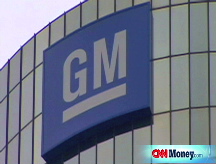Battle of the bailouts
Investors have to weight the downgrade of 12 big banks by S&P as well as the $13.4B loan to GM and Chrysler. Should auto elation trump bank fears?
NEW YORK (CNNMoney.com) -- There's more bad news for big banks - but good news for the Big Three. And investors are having a difficult time trying to make sense of it all.
Friday morning was shaping up to be an ugly day on Wall Street following Thursday's late sell-off and more market slides overseas.
It didn't help matters that credit rating agency Standard & Poor's downgraded its outlook on a dozen big U.S. and European banks, including Barclays (BCS), Citigroup (C, Fortune 500), JPMorgan Chase (JPM, Fortune 500) and UBS (UBS).
Sentiment improved immediately after the White House unveiled the long-awaited bailout of General Motors (GM, Fortune 500) and Chrysler, though. The automakers will receive $13.4 billion in loans from the $700 billion bank bailout fund (aka TARP), with the potential of another $4 billion coming early next year.
The market enjoyed a nice rally in the morning...but it fizzled by midday. So what should investors focus on as the end of the year rapidly approaches?
The rescue plan for GM and Chrysler is certainly good news.
John Derrick, director of research with U.S. Global Investors Inc., a money-management firm based in San Antonio, said that keeping GM and Chrysler afloat should prevent a painful ripple effect for Ford (F, Fortune 500), Asian automakers like Toyota (TM) and parts suppliers.
"I know there is a lot of popular opposition to the bailout. But with the economy in crisis mode already, this loan was one thing that needed to happen before the end of the year," Derrick said.
But this stopgap measure is just the beginning of what will probably be a major restructuring of the industry. So it's not surprising that the initial auto euphoria quickly waned.
"There will be a slow realization that consumers are tapped out and will have to retrench. We have the capacity to build more than 18 million autos a year but we probably only need little more than 10 million," said Peter Sorrentino, senior portfolio manager with Huntington Asset Advisors in Cincinnati.
Investors also shouldn't overlook the problems facing banks, which have already received about half of the $700 billion in bailout funds approved for them in October. The Treasury Department is expected to ask Congress to release the remaining $350 billion sometime early next year.
And according to S&P, many banks will probably need the money.
In its report, S&P said its downgrade was based on expectations of "significant pressure on large complex financial institutions' future performance due to increasing bank industry risk and the deepening global economic slowdown."
In addition, the ratings agency indicated that there may be an increased likelihood of governments needing to provide what it called "extraordinary support" to banks.
"Many governments have intervened directly as a result of or in anticipation of deeper solvency pressures at specific institutions," S&P noted.
That doesn't bode well for the broader market.
"For the market overall to have a sustainable reality, banks are going to have to be a part of that," Derrick said. "Ultimately banks have to start lending again and they don't seem to be doing so. They are in a capital-preservation mode."
Sorrentino agreed. He said some bankers have told him that when the government decided to invest in their rims, regulators instructed them to hold onto capital so could buy up weaker banks in danger of collapse.
So in the same way that the government is trying to prevent what President Bush described Friday as the "disorderly bankruptcy and liquidation" of the auto industry, it may be doing the same with the banking sector.
"There is an orderly laying out for the consolidation of the banking industry. You are seeing capital allocated accordingly," Sorrentino said.
Which means the troubles plaguing two critical sectors of the economy are far from over. ![]()




